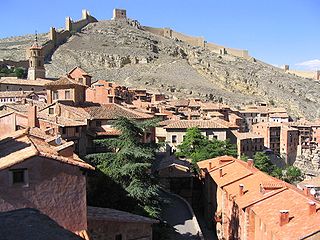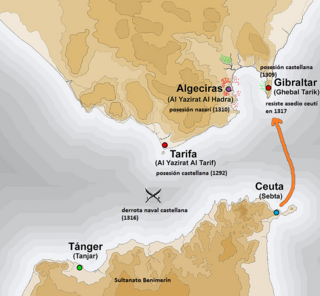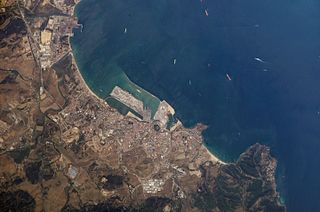
Year 1309 (MCCCIX) was a common year starting on Wednesday of the Julian calendar.

Ferdinand IV of Castile called the Summoned, was King of Castile and León from 1295 until his death.

María Alfonso Téllez de Meneses, known as María de Molina, was queen consort of Castile and León from 1284 to 1295 by marriage to Sancho IV of Castile, and served as regent for her minor son Ferdinand IV and later her grandson Alfonso XI of Castile (1312-1321).
Nasr, full name Abu al-Juyush Nasr ibn Muhammad, was the fourth Nasrid ruler of the Emirate of Granada from 14 March 1309 until his abdication on 8 February 1314. He was the son of Muhammad II al-Faqih and Shams al-Duha. He ascended the throne after his brother Muhammad III was dethroned in a palace revolution. At the time of his accession, Granada faced a three-front war against Castile, Aragon and the Marinid Sultanate, triggered by his predecessor's foreign policy. He made peace with the Marinids in September 1309, ceding to them the African port of Ceuta, which had already been captured, as well as Algeciras and Ronda in Europe. Granada lost Gibraltar to a Castilian siege in September, but successfully defended Algeciras until it was given to the Marinids, who continued its defense until the siege was abandoned in January 1310. James II of Aragon sued for peace after Granadan defenders defeated the Aragonese siege of Almería in December 1309, withdrawing his forces and leaving the Emirate's territories by January. In the ensuing treaty, Nasr agreed to pay tributes and indemnities to Ferdinand IV of Castile and yield some border towns in exchange for seven years of peace.
Abu ar-Rabi Sulayman was a Marinid ruler of Morocco. He was the son or grandson of Abu Yaqub Yusuf and brother of Abu Thabit Amir, whom he succeeded in 1308, at the age of 19.

Diego López V de Haro, nicknamed el Intruso, was a Spanish noble of the House of Haro and held the title of the Lord of Biscay which he took from the pretender to the title, John of Castile.

Juan Núñez II de Lara, nicknamed el Mozo or el de la Barba, was a Spanish noble, and head of the House of Lara in the service of the Kingdom of Castile.

Juan III Núñez de Lara y de la Cerda, Lord of Lara and Vizcaya, son of Ferdinand de la Cerda (1275–1322) and Juana Núñez de Lara the Little Dove. Despite belonging to the House de la Cerda and aspiring to the Castilian-Leonese throne during the reigns of Sancho IV of Castile, Ferdinand IV of Castile and Alfonso XI of Castile, he carried the family name of his mother which corresponded to the name of his lordship.

Nuño González III de Lara was a Castilian noble of the House of Lara. He was the lord consort of Alegrete, Vide, and Sintra and served as Alférez del rey for King Ferdinand IV of Castile.

María Díaz I de Haro "the Good" (1270–1342) was a Spanish noblewoman of the House of Haro. She was the daughter of Lope Díaz III de Haro who was assassinated by order of the king at Alfaro, La Rioja. She is best known for being the Lady of Biscay and for her lifelong battle against her uncle, Diego López V de Haro, for the title of the lordship of Biscay.

Lope Díaz de Haro was a Spanish noble of the House of Haro, the traditional Lords of Biscay. He was the firstborn son of Diego Lopez V de Haro, Lord of Biscay. Whilst he did not inherit his father's title of Lordship over Biscay, he is best known for being the lord of Orduña-Urduña and of Balmaseda. He further served as Alférez to King Ferdinand IV of Castile.

The first siege of Gibraltar was a battle of the Spanish Reconquista that took place in 1309. The battle pitted the forces of the Crown of Castile under the command of Juan Núñez II de Lara and Alonso Pérez de Guzmán, against the forces of the Emirate of Granada who were under the command of Sultan Muhammed III and his brother, Abu'l-Juyush Nasr.

Garci López de Padilla was a Spanish noble of the House of Padilla. He was the fifteenth Grand Master of the Order of Calatrava from 1296 to 1322. He is best known for his command of the Castilian forces at the Siege of Gibraltar and his participation in the greater campaign against the Kingdom of Granada undertaken by Ferdinand IV of Castile in 1309.

Juan Núñez I de Lara y León, also known as "el Gordo" or "the Fat", was a Spanish noble. He was the head of the House of Lara, Lord of Lerma, Amaya, Dueñas, Palenzuela, Tordehumos, Torrelobatón, and la Mota. He was further known as Señor de Albarracín through his first marriage with Teresa Álvarez de Azagra.

The siege of Albarracín was a battle fought during the reign of Peter III of Aragon, King of Aragón from the months of April to September 1284. Albarracín, which had for some time belonged to Juan Núñez I de Lara, the head of the House of Lara, was besieged by an Aragonese force. The siege resulted in the successful taking of the city by Aragonese forces after which, Peter III handed gifted the city to his illegitimate son, Ferdinand of Aragón.

The second siege of Gibraltar was an abortive attempt in 1316 by the forces of the Azafid Ceuta and the Nasrid Emirate of Granada to recapture Gibraltar, which had fallen to the forces of Ferdinand IV of Castile in 1309.

The siege of Algeciras (1342–1344) was undertaken during the Reconquest of Spain by the Castillian forces of Alfonso XI assisted by the fleets of the Kingdom of Aragon and the Republic of Genoa. The objective was to capture the Muslim city of Al-Jazeera Al-Khadra, called Algeciras by Christians. The city was the capital and the main port of the European territory of the Marinid Empire.
The siege of Almería was an unsuccessful attempt by Aragon to capture the city of Almería from the Emirate of Granada in 1309. Almería, a Mediterranean port in the southeast of the emirate, was the initial Aragonese target in a joint Aragonese-Castilian campaign aimed at conquering Granada. The Aragonese troops led by their King James II arrived on 11 August, blockading the city and employing siege engines. The city, led by governor Abu Maydan Shuayb and naval commander Abu al-Hasan al-Randahi, prepared for the siege by strengthening its defenses and stockpiling food. Throughout the siege, both sides exchanged shots from siege engines and engaged in fields battles and skirmishes with varying results. James ordered multiple unsuccessful assaults. A Granadan relief column under Uthman ibn Abi al-Ula arrived nearby in September and harassed the besiegers.
The Battle of Ceuta (1309) was a military confrontation between the Crown of Aragon and the Nasrid kingdom of Granada in the city of Ceuta during the Castilian-Granadian War from 1309 to 1319. The Benimerin Sultanate wished to occupy the city but lacked a navy to carry out the enterprise. The Crown of Aragon, which had gone to war against the Granada, set out to conquer the city for the Benimerins.














